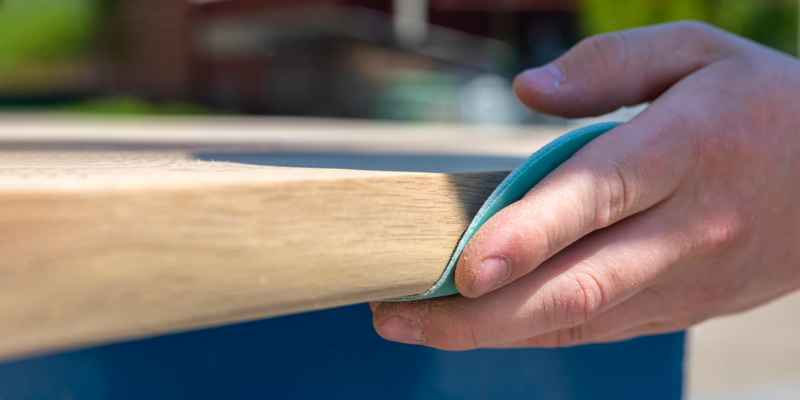To bevel wood by hand, use a chisel or hand plane to cut the desired angle. Start by marking the bevel and then carefully plane or chisel along the marked line to create a smooth, angled edge.
Hand tools like chisels and planes allow for precision and control when creating beveled edges on wood. By following these steps, you can achieve a clean and accurate bevel on your wooden projects without the need for power tools. Beveling wood by hand adds a personal touch to your woodworking projects and allows for a hands-on approach to craftsmanship.
Mastering the skill of hand beveling opens up a world of creative possibilities in woodworking.
Essential Tools For Hand Beveling
To bevel wood by hand, you’ll need essential tools like a chisel, bevel gauge, knife, hand saw, bevel cut techniques, and a sliding bevel. These tools will help you achieve precise and accurate beveled edges in your woodworking projects.
Chisel
A chisel is an essential tool for hand beveling as it allows precise and controlled shaving of wood to create the desired angle. This tool is especially useful for fine-tuning and detailing the edges of the wood to achieve a smooth bevel.
Bevel Gauge
A bevel gauge is indispensable for accurately measuring and transferring angles to the wood. It helps ensure precision and consistency in the bevel cuts, making it an essential tool for achieving professional-quality results.
Knife
Another important tool for hand beveling is a knife. It is used for scoring and marking the wood, providing a guide for the bevel cuts. A sharp and precise knife is crucial for creating clean and accurate bevels.
Hand Saw
A hand saw is a versatile tool for creating bevels on wood. Whether it’s a coping saw or a hacksaw, this tool is essential for cutting the wood along the marked bevel lines, allowing for controlled and efficient removal of material to achieve the desired angle.
Plane
A plane is an indispensable tool for smoothing and refining the beveled edges. It allows for precise material removal and provides a smooth finish, essential for achieving a professional-looking bevel on wood.
Beveling Techniques
Beveling wood by hand requires precision and the right techniques. Mastering beveling techniques can enhance the detail and finish of your woodworking projects. Below are some effective methods to achieve clean bevels:
Using A Hand Plane
- Begin by marking the bevel angle on the wood surface.
- Secure the wood piece and adjust the hand plane blade to the desired angle.
- With steady strokes, run the hand plane along the edge of the wood to create a smooth bevel.
Hand Saw Techniques
- Choose a hand saw suitable for bevel cuts like a coping saw or hacksaw.
- Use a bevel gauge to measure and mark the desired angle on the wood.
- Secure the wood piece and carefully make precise bevel cuts following the marked angle.
Beveling With Power Tools
- Power tools like a miter saw can also be used for bevel cuts.
- Adjust the blade to the desired angle and securely clamp the wood for safety.
- Make the cut following the marked angle to achieve accurate bevels efficiently.
Creating Bevels Without A Table Saw
- Utilize hand tools such as hand planes and saws for bevel cuts if a table saw is not available.
- Mark the desired bevel angle on the wood using a bevel gauge and ensure the wood piece is secured.
- Execute precise cuts following the marked angle to achieve clean bevel edges without a table saw.
Precision And Accuracy
Achieving precision and accuracy when beveling wood by hand involves using the appropriate tools like a chisel or hand plane, measuring with a bevel gauge, and carefully cutting the wood at the desired angle. Consistent practice and attention to detail are key for successful hand beveling techniques.
Measuring And Marking
Before making accurate bevel cuts on wood, it is crucial to start with precise measuring and marking. This step ensures that your bevel cuts are consistent and accurate throughout your project. Use a bevel gauge to measure and transfer the desired angle onto your workpiece. Secure the bevel gauge in place and then mark the angle with a pencil or marking knife. Double-check your measurements before moving on to the actual cutting process.
Tips For Accurate Bevel Cuts
- Choose the Right Tools: Bevel cuts can be done using either hand tools or power tools. If you prefer using hand tools, you will need a coping saw or a hacksaw, along with a bevel gauge for measuring angles and clamps for securing the workpiece.
- Secure the Workpiece: When making bevel cuts, it is essential to secure the workpiece to prevent it from moving or slipping during the cutting process. Use clamps or a vise to firmly hold the wood in place.
- Practice Smooth and Controlled Cutting: To achieve precise bevel cuts, it is important to cut slowly and steadily, maintaining control over the tool. Take your time and focus on maintaining a consistent angle throughout the cut.
- Double-Check Angle Measurements: Before making any cuts on your workpiece, always double-check the angle measurements using a bevel gauge. This ensures that you are cutting at the correct angle and helps prevent any mistakes or inaccuracies.
- Test Cuts on Scrap Wood: If you are unsure about the accuracy of your bevel cuts, it is always a good idea to practice on scrap wood first. This allows you to make any necessary adjustments before working on your actual project.
- Refine and Sand the Cut: After making the bevel cuts, it is important to refine and sand the edges for a smooth and professional finish. Use sandpaper or a file to remove any rough edges or imperfections.
Common Mistakes And How To Avoid Them

When it comes to beveling wood by hand, there are common mistakes that can easily be made. By understanding these mistakes and learning how to avoid them, you can perfect your beveling technique and achieve smooth, precise results. In this section, we will discuss two common mistakes: uneven bevels and tearing of wood fiber. Let’s delve into each of these mistakes and explore how to avoid them.
Uneven Bevels
One common mistake when beveling wood by hand is creating uneven bevels. This can result in a lack of symmetry and a less professional finish. To avoid this mistake, follow these steps:
- Measure and mark: Begin by accurately measuring and marking the desired angle on the wood. Use a bevel gauge to ensure precise measurements.
- Select the right tool: Choose the appropriate tool for your beveling task, such as a chisel or hand plane. Ensure that the tool is sharp and in good condition.
- Establish a starting bevel: Start by creating a small bevel at the marked angle. This will act as a guide for the rest of the beveling process.
- Work incrementally: Gradually increase the bevel size, taking care to maintain symmetry. Use a light touch and make small, controlled movements.
- Frequent checks: Regularly check the bevel size and symmetry with a bevel gauge or another reliable measuring tool. Make adjustments as necessary.
- Finish with finesse: Once the bevel is close to the desired size, switch to finer grit sandpaper or a sanding block to refine and smooth the surface.
By following these steps, you can ensure that your bevels are even and symmetrical, resulting in a professional-looking finish.
Tearing Of Wood Fiber
Another common mistake to avoid when beveling wood by hand is tearing of wood fiber. This can occur when too much force is applied or when using a dull or inappropriate tool. To prevent tearing of wood fiber, keep the following tips in mind:
- Sharp tools: Ensure that your tools are sharp and well-maintained. Dull tools are more likely to tear the wood fiber.
- Proper technique: Use the correct technique for your chosen tool. For example, when using a chisel, use a downward slicing motion rather than hacking or applying excessive force.
- Controlled movements: Take your time and work slowly and steadily. This will minimize the likelihood of tearing the wood fiber.
- Support the wood: Provide adequate support for the wood to prevent unnecessary flexing or vibration, which can lead to tearing.
- Consider grain direction: Pay attention to the direction of the wood grain and adjust your technique accordingly. Be mindful of any potential weak spots where tearing may be more likely to occur.
By following these tips, you can avoid tearing the wood fiber and achieve clean, smooth bevels without any unsightly damage.
Finishing And Refining Beveled Edges
When it comes to finishing and refining beveled edges on wood, attention to detail is key. Smoothening the surface and adding decorative touches can elevate the overall look of your woodworking project.
Smoothening The Beveled Surface
- Start by using a sandpaper with a fine grit to smooth out any rough edges on the beveled surface.
- Work in circular motions to ensure an even finish and remove any imperfections.
- Gradually increase the grit of the sandpaper to achieve a smooth and polished surface.
Adding Decorative Touches
- Consider router techniques to create intricate designs or patterns along the beveled edge for a customized look.
- Use wood burning tools to add unique accents or engrave details that enhance the visual appeal of the bevel.
- Apply a stain or finish to the beveled surface to protect the wood and add depth to the overall finish.
Expert Insights And Best Practices
Achieving a precise bevel on wood by hand requires expert insights and best practices. To start, secure the wood and mark the bevel angle, then carefully cut along the marked line using a chisel, hand plane, or hand saw. These methods ensure a smooth and accurate beveled edge, enhancing the overall quality of the woodwork.
Tips From Expert Woodworkers
When it comes to beveling wood by hand, there is no shortage of expert insights and best practices from master woodworkers. These seasoned professionals have honed their craft and have some valuable tips to share. Whether you’re a beginner looking to improve your skills or an experienced woodworker wanting to refine your technique, here are some tips from the pros:
Advice For Beginners
- Start with the right tools: To achieve clean and precise bevel cuts, it’s essential to have the right tools. A chisel and a good quality bevel gauge are must-haves for accurate measurements and cutting angles.
- Practice proper technique: Consistency is key when it comes to beveling wood. Make sure to hold your chisel at the correct angle and apply steady pressure as you cut to ensure smooth and even bevels.
- Measure twice, cut once: Taking accurate measurements is crucial to achieving the desired angle for your bevel. Use a bevel gauge to double-check your measurements before making any cuts.
- Use clamps for stability: Securing your workpiece with clamps will prevent it from moving or shifting while you’re making the bevel cuts. This stability is essential for achieving clean and precise results.
- Practice on scrap wood: Before attempting bevel cuts on your actual project, it’s a good idea to practice on scrap wood. This will allow you to familiarize yourself with the technique and make any necessary adjustments before working on your final piece.
- Take your time: Don’t rush the beveling process. Take your time to ensure each cut is accurate and clean. Remember, practice makes perfect, so patience is key.
By following these tips from expert woodworkers and incorporating them into your own woodworking practice, you can improve your beveling skills and achieve professional-looking results. Remember to start with the right tools, practice proper technique, and take your time for best results.
Conclusion And Further Resources
Final Thoughts
Crafting bevels by hand adds a unique touch to woodworking projects. With practice, precision is achievable.
Additional Reading And Videos
- Explore tutorials on YouTube for visual guidance on hand beveling techniques.
- Find in-depth articles on woodworking websites for further understanding of beveling processes.
- Learn from the woodworking community on forums about tips and tricks for achieving perfect bevel cuts.

Frequently Asked Questions Of How To Bevel Wood By Hand
How Do You Cut A Bevel Without A Table Saw?
To cut a bevel without a table saw, use a hand saw and a bevel gauge to measure the angle. Secure the wood with clamps and make the cut. Alternatively, a jointer or circular saw can also be used for bevel cuts.
You can also hand plane the beveled edges for a smooth finish.
What Tool Is Used To Bevel Wood?
A chisel or hand plane is used to bevel wood for creating angled edges. Other tools include a bevel gauge and hand saw for precise cuts.
Can You Make A Bevel Cut With A Hand Saw?
Yes, you can make a bevel cut with a hand saw. Use a coping saw or a hacksaw, along with a bevel gauge and clamps to measure and secure your desired angle.
How Do You Cut Beveled Edges On Wood?
To cut beveled edges on wood, use a table saw or miter saw. Tilt the blade to the desired angle and make your cut. You can also use hand tools like a hand saw and bevel gauge for measuring angles.
Clamps may be needed for stability.
Conclusion
When you’re beveling wood by hand, precision is key. Take your time and practice for smooth results. Don’t rush the process; enjoy the craftsmanship that hand beveling offers. With patience and attention to detail, you’ll achieve professional-looking beveled edges on your woodworking projects.
Happy crafting!


